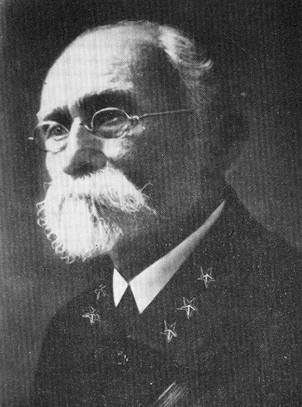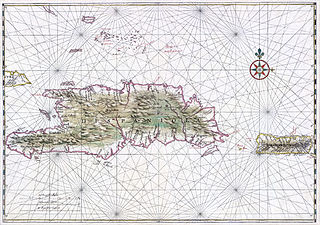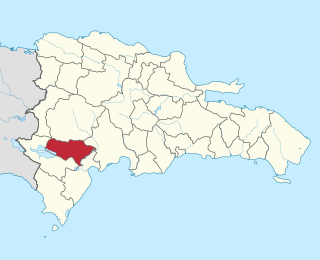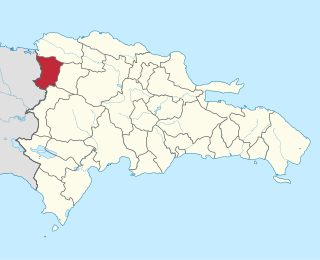
Máximo Gómez y Báez was a Dominican Generalissimo in Cuba's War of Independence (1895–1898). He was known for his controversial scorched-earth policy, which entailed dynamiting passenger trains and torching the Spanish loyalists' property and sugar plantations—including many owned by Americans. He greatly increased the efficacy of the attacks by torturing and killing not only Spanish soldiers, but also Spanish sympathizers and especially Cubans loyal to Spain. By the time the Spanish–American War broke out in April 1898, the rebellion was virtually defeated in most of Western Cuba, with only a few operating pockets in the center and the east. He refused to join forces with the Spanish in fighting off the United States, and he retired to the Quinta de los Molinos, a luxury villa outside of Havana after the war's end formerly used by captains generals as summer residence.

The Dominican War of Independence made the Dominican Republic a sovereign state on February 27, 1844. Before the war, the island of Hispaniola had been united for 22 years when the newly independent nation, previously known as the Captaincy General of Santo Domingo, was unified with the Republic of Haiti in 1822. The criollo class within the country overthrew the Spanish crown in 1821 before unifying with Haiti a year later.
The Folville gang were an armed band operating in Leicestershire in the early 14th century led by Eustace Folville.
The military history of Cuba begins with the island's conquest by the Spanish and its battles afterward to gain its independence. After the Communist takeover by Fidel Castro in 1959, Cuba became involved in many major conflicts of the Cold War in Africa and the Middle East, where it supported Marxist governments and fought against Western proxies. Castro's Cuba had some 39,000–40,000 military personnel abroad by the late 1970s, with the bulk of the forces in Sub-Saharan Africa but with some 1,365 stationed in the Middle East and North Africa. Cuban forces in Africa were mainly black and mulatto.
The Battle of Azua was the first major battle of the Dominican War of Independence and was fought on the 19 March 1844, at Azua de Compostela, Azua Province. A force of some 2,200 Dominican troops, a portion of the Army of the South, led by General Pedro Santana and General Antonio Duvergé defeated an outnumbering force of 10,000 troops of the Haitian Army led by General Souffrand.
The Battle of Santiago was the second major battle of the Dominican War of Independence and was fought on the 30 March 1844, at Santiago de los Caballeros, Santiago Province. Although outnumbered, Dominican troops, part of the Army of The North and led by General José María Imbert, defeated Haitian Army troops led by General Jean-Louis Pierrot.

The Battle of Tortuguero was the first naval battle of the Dominican War of Independence and was fought on 15 April 1844 at Tortuguero, Azua Province. A force of three Dominican schooners led by Commander Juan Bautista Cambiaso defeated a force of three vessels of the Haitian Navy. Though it was a minor naval battle engagement, it determined the naval supremacy of the Dominican Republic over Haiti until the end of the war.

The Battle of Las Carreras was a major battle during the years after the Dominican War of Independence and was fought on the 21–22 April 1849, nearby Baní, Peravia Province. A force of 800 Dominican troops, a portion of the Army of the South, led by General Pedro Santana, defeated an outnumbering force of 10,000 troops of the Haitian Army led by Faustin Soulouque.

The Battle of El Número was a major battle during the years after the Dominican War of Independence and was fought on the 17 April 1849, nearby Azua de Compostela, Azua Province. A force of 300 Dominican troops, a portion of the Army of the South, led by General Francisco Domínguez and General Antonio Duvergé encountered an outnumbering force of 10,000 troops of the Haitian Army led by General Jean Francois Jeannot.

The Battle of Estrelleta was a major battle of the Dominican War of Independence and was fought on September 17, 1845, at the site of Estrelleta, near Las Matas de Farfán, San Juan Province. A force of Dominican troops, a portion of the Army of the South, led by General Antonio Duvergé, defeated an outnumbering force of the Haitian Army led by General Jean-Louis Pierrot.

The Battle of Cabeza de Las Marías and Las Hicoteas were the first military engagements of the Dominican War of Independence and were fought between the 13 and 18 March 1844, at Cabeza de Las Marías, near Neyba, Baoruco Province and Las Hicoteas, near Azua de Compostela, Azua Province. A force of 500 Dominican troops, a portion of the Army of the South, led by General Manuel de Regla Mota, encountered an outnumbering force of 10,000 troops of the Haitian Army led by General Souffrand and was forced to flee to Azua de Compostela.
The Battle of El Memiso was the third major battle of the Dominican War of Independence and was fought on the 13 April 1844, at El Memiso, Azua Province. A force of Dominican troops, a portion of the Army of the South, led by General Antonio Duvergé, defeated an outnumbering force of the Haitian Army led by Col. Pierre Paul.

The war for Spanish reestablishment in Santo Domingo, better known as the Reconquista, was fought between November 7, 1808, and July 9, 1809. In 1808, following Napoleon's invasion of Spain, the criollos of Santo Domingo revolted against French rule and their struggle culminated in 1809 with a return to the Spanish colonial rule for a period commonly termed España Boba.

The Dominican Civil War, also known as the April Revolution, took place between April 24, 1965, and September 3, 1965, in Santo Domingo, Dominican Republic. It started when civilian and military supporters of the overthrown democratically-elected president Juan Bosch ousted the militarily-installed president Donald Reid Cabral from office. The second coup prompted General Elías Wessin y Wessin to organize elements of the military loyal to President Reid ("loyalists"), initiating an armed campaign against the "constitutionalist" rebels. In riposte, the dissidents passed out Cristóbal carbines and machine guns to several thousand civilian sympathizers and adherents. Allegations of foreign communist support for the rebels led to a United States intervention in the conflict, which later transformed into an Organization of American States occupation of the country by the Inter-American Peace Force. Elections were held in 1966, in the aftermath of which Joaquín Balaguer was elected into the presidential seat. Later in the same year, foreign troops departed from the country.

Divisional General José María Bartolomé Imbert Duplessis (né Joseph Marie Barthélemy Imbert; was a French-born Dominican military figure and a mayor of Moca.

The Battle of Fuente del Rodeo was the first armed encounter against Haiti in the Dominican War of Independence. It was fought on the 13 March 1844 in the province of Bahoruco. A force of Dominican troops, a portion of the Army of the South, led by General Fernando Taveras, defeated an outnumbering force of the Haitian Army led by Charles Rivière-Hérard. The Dominicans fought with stones, knives, machetes, lances, clubs and rifles.

The Battle of Sabana Larga was a major battle during the years after the Dominican War of Independence. It was fought on 24 January 1856 in Sabana Larga, Dajabón. A force of 8,000 Dominican troops of the northern army, led by General Juan Luis Franco Bidó, defeated a numerically larger force of 22,000 troops of the Haitian army under Emperor Faustin I. Another part of the Haitian army was entrenched in Jácuba near Puerto Plata, but were defeated by Florentino and General Peter Lucas Peña.
The siege of Santo Domingo (1808) was the second and final major battle of the Spanish reconquest of Santo Domingo and was fought between November 7, 1808 and July 11, 1809 at Santo Domingo, Captaincy General of Santo Domingo. A force of Dominican and Puerto Rican of 1,850 troops led by Gen. Juan Sánchez Ramírez, with a naval blockaded by British Commander Hugh Lyle Carmichael, besieged and captured the city of Santo Domingo after an 8 months garrisoning of 2,000 troops of the French Army led by General Dubarquier.
The Battle of Fort Cachimán was a battle of the Dominican War of Independence and was fought on the 6 December 1844 at the border close to Elías Piña. A force of Dominican troops, a portion of the Army of the South, led by General Antonio Duvergé, defeated an outnumbering force of the Haitian Army led by General Seraphin and captured the Haitian fort.

The Battle of Cambronal was a major battle during the years after the Dominican War of Independence and was fought on 22 December 1855, in Cambronal, near Neiba. A detachment of Dominican troops forming part of the Army of the South, led by General Francisco Sosa, defeated an outnumbering force of the Haitian Army led by General Pierre Rivere Garat.













